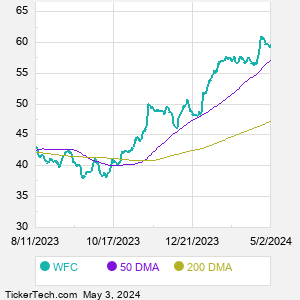Wells Fargo & Company is a financial holding company and a bank holding company. Through its subsidiaries, Co. provides banking, investment and mortgage products and services, as well as consumer and commercial finance. Co. provides consumer financial products and services including checking and savings accounts, credit and debit cards, and auto, mortgage and home equity, and small business lending, as well as financial planning, private banking, investment management, and fiduciary services. Co. also provides financial solutions including commercial loans and lines of credit, letters of credit, asset-based lending, trade financing, treasury management, and investment banking services.
When researching a stock like Wells Fargo, many investors are the most familiar with Fundamental Analysis — looking at a company's balance sheet, earnings, revenues, and what's happening in that company's underlying business. Investors who use Fundamental Analysis to identify good stocks to buy or sell can also benefit from WFC Technical Analysis to help find a good entry or exit point. Technical Analysis is blind to the fundamentals and looks only at the trading data for WFC stock — the real life supply and demand for the stock over time — and examines that data in different ways. One of those ways is to calculate a Simpe Moving Average ("SMA") by looking back a certain number of days. One of the most popular "longer look-backs" is the WFC 200 day moving average ("WFC 200 DMA"), while one of the most popular "shorter look-backs" is the WFC 50 day moving average ("WFC 50 DMA"). A chart showing both of these popular moving averages is shown on this page for Wells Fargo. Comparing two moving averages against each other can be a useful visualization tool: by calculating the difference between the WFC 200 DMA and the WFC 50 DMA, we get a moving average convergence divergence indicator ("WFC MACD"). The WFC MACD chart, in conjunction with the chart of the moving averages, basically helps in visualizing how the moving averages are showing convergence (moving closer together), or divergence (moving farther apart). |



